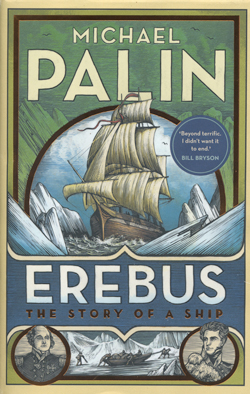
Michael Palin’s
Erebus is not only a good read, but also a well-researched account of a remarkable vessel, which helped pioneer the exploration of polar regions in the mid-19th century. Today, H.M.S.
Erebus is most famous for its tragic loss in the late 1840s, along with its sister ship HMS
Terror, their 129-strong crews and leader Sir John Franklin, whilst searching for the North West Passage between the Atlantic and Pacific oceans.
However, as Palin vividly recounts, over a four-year period from 1839 to 1843,
Erebus and
Terror had successfully taken James Clark Ross and his expedition repeatedly into Antarctic waters from an over-wintering base in Tasmania and brought them safely back to Britain. In our typically British way, Franklin’s ‘glorious’ failure is hugely celebrated, whilst Ross’s great scientific achievement is largely ignored. Hopefully, Palin’s
Erebus will help restore the balance.
For geologists it is the Antarctic part of the
Erebus story that is perhaps of most interest. The 1838 British Association for the Advancement of Science meeting had recognized the need to measure terrestrial magnetism. Scientists such as the astronomer John Herschel [1792-1871] and the soldier-turned-geophysicist Edward Sabine [1788-1883] successfully prevailed upon Lord Melbourne [1779-1848], the prime minister, to support a magnetic survey of Antarctica. For the task, the Admiralty refitted two ‘retired’ warships, HMS
Erebus and HMS
Terror. Known as bomb-ships, their small size, shallow draught and reinforced hulls to withstand the recoil from their armament of siege mortars and cannon, proved well-suited for tackling icy polar seas.
Under the captaincy of James Clark Ross [1800-1862], the aim of the voyage was to help establish a system of magnetic observatories across the southern hemisphere. Scientifically, Ross was supported by his surgeon, Robert McCormick [1800-1890], and the assistant surgeon Joseph Dalton Hooker [1817-1911]. Whilst Hooker was knighted and showered with honours for many subsequent achievements in botany and palaeobotany, McCormick has largely slipped from view. He is mainly remembered for abandoning HMS
Beagle at Rio de Janiero in 1832, complaining that Captain Fitzroy favoured Darwin and provided him with greater opportunities for collecting.
Palin quotes Hooker recounting to his father how McCormick ‘…takes no interest but in bird shooting and collecting rocks. I am
nolens volens the Naturalist for which I enjoy no other advantage other than the Captain’s cabin, and think myself amply repaid’. Like Darwin, McCormick was an excellent shot. On his return to England, the unfortunate McCormick tried repeatedly for advancement in the Navy and eventually, in 1859 became Deputy Inspector of Hospitals. He even had to privately publish his account of his polar and global seafaring, but this has been republished in recent years (
Voyages of Discovery in Arctic and Antarctic Seas, and Round the World, by R. McCormick 1884 reprint 2014, Cambridge University Press, 2 vols. ISBN 9781108071710).
Fortunately, Palin resists the temptation to recount the tale as one of his famous ‘
Ripping Yarns’, but at times it is difficult not to view the ultimately tragic tale of Franklin,
Erebus and
Terror as another ‘
Ripping Yarn’.
Reviewed by Douglas Palmer
EREBUS: THE STORY OF A SHIP, by Michael Palin, 2018. Published by: Random House Books, 352 pp. (hbk.) ISBN 978184120.
List Price: £20.00
W: www.penguin.co.uk